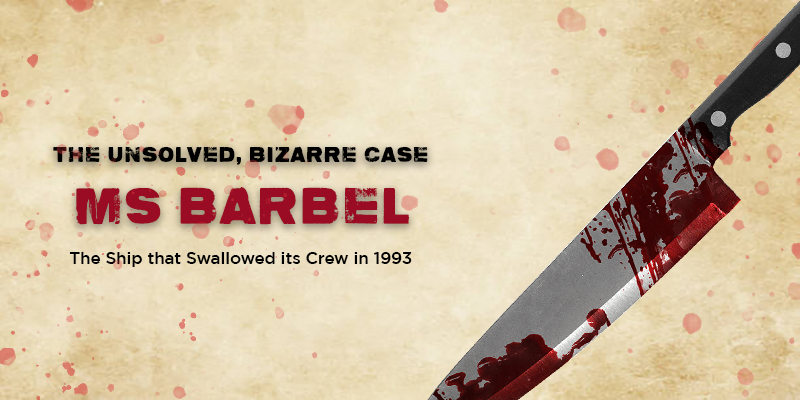The seas are one of the places that have fascinated mankind for a long time now. Lots of mysterious things that have happened, and even more of them have been unsolved, still barely out of the pages of mythos, having been switched there for being too “bizarre” and “implausible” to have occurred. And for the most cases, these seem to be true. For example, take the case of The Perrier ship that was supposedly haunted so intensely that multiple crew committed suicide, and even more went insane. However, that eventually turned out to be nothing more than an old wives tale.
Then, of course, there is the tale of Mary Celeste, the ship that was found afloat with no crew on board. That was more documented, because it actually occurred; however, that story is not closer to be solved than it was in 1872. The case of the Ourang Medan is also up there, but there is also a good chance that it could be an urban legend as well.

The German coaster, the ms Bärbel. Right, in the center, The Russian sailor, Andrej Lapin, who was charged
This is where the case of the Bärbel comes in. This is an actual, documented case of a ship that went missing in 1993 along with the crew. Even strangely, when the fishermen off the coast of Denmark embarked on the ship when it was found floating aimlessly, they were startled to find that the ship was devoid of the crew. Then, the story goes even stranger.
The Bärbel Ship is Found Without Its Crew
In the late summer of 1993, M/S Bärbel was chartered by Meerpahl & Meyer and embarked on a journey from London to Rostock, its hull laden with rapeseed. The voyage commenced smoothly, with the captain placing a routine call to his wife on the morning of August 15, 1993, reporting no issues. However, an inexplicable and fatal altercation soon disrupted the vessel’s course. The incident that occurred remains unknown, but it would change the fate of the crew, and the course of the ship.
Three days later, on August 18, 1993, the Bärbel ship was discovered adrift and abandoned by two fishing cutters, HG 270 Tannisbugt and HG 271 Normark, hailing from Hirtshals. It was found approximately 85 nautical miles west of Esbjerg, far off its intended path. The sole survivor of the Bärbel’s original crew was a Russian sailor named Andrej Lapin. He was found adrift in a rubber dinghy near the abandoned ship. Surprisingly, Lapin appeared utterly calm about his situation, showing no signs of distress or urgency. Among his belongings was a substantial sum of money (nearly 60,000 Deutsche marks, six cans of peaches, two suitcases, his passport, and a duvet, painting a peculiar picture of a man seemingly prepared for an unexpected journey. The whereabouts of the remaining crew were unknown.

The axe murder ship, the MS Barbel that was found floating aimlessly in an undated photo
On the morning of August 19, the Bärbel was towed into the port of Esbjerg, Denmark. Investigators soon uncovered a disturbing scene: traces of blood, hair, and skin scattered in various locations, alongside signs of violent confrontations and attempted arson. Lapin’s initial claim—that he fled in a life raft after a fire broke out—did not align with the evidence of looting and violence on board. Consequently, he was detained by Danish authorities.
The mystery deepened when, on September 14, Dutch fishermen recovered the body of Captain Telkmann, which was discovered floating in the ocean by fishermen. Reports suggest that the body was badly decomposed and could only be recognized by the loose clothing that was found on the body and the articles found in his coat. By April 1994, another body, possibly that of a crew member, washed ashore in Sweden. On December 13, 1993, Lapin was handed over to German police as the investigation unraveled deepened into the ill-fated voyage.
Andrej Lapin is brought to court for killing the crew of the Bärbel
On August 19, 1993, Andrej Lapin was charged with arson and five counts of murder. He was deported to Germany from Denmark on December 13, 1993, and his initial trial began on September 5, 1994. Lapin had remained silent with German authorities before his trial, but appeared at the Osnabrück district court well-dressed and ready to answer all questions.
On September 5, 1994, the Osnabrück public prosecutor’s office brought charges against Andrej Lapin, accusing him of murdering four Russian sailors—engineer Mikhail Mikhailov, sailor Vladislav Bogdan, helmsman Viktor Varenko, and cook Anatolij Smolijak—as well as the 50-year-old captain, Heinrich Telkmann, from Haren. The prosecution claimed Lapin committed these heinous acts out of greed before throwing the bodies overboard.
Lapin’s account painted a different picture. He asserted that two crew members had killed the captain and the other two sailors with an axe. In a desperate act of self-defense, Lapin claimed he turned the axe on the assailants, killing them. Fearing disbelief and the consequences, he confessed to disposing of the bodies overboard and attempting to set the ship ablaze. He also maintained that the 60,000 Deutsche Marks found in his possession were earned by selling Russian icons.
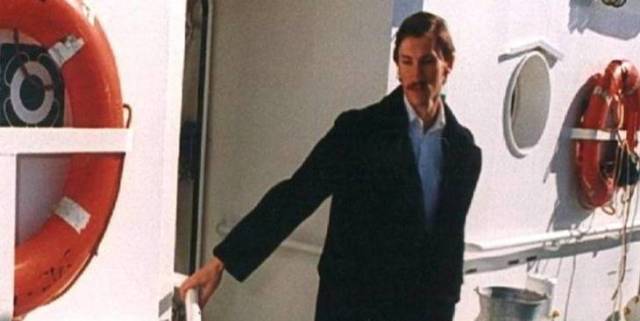
Andrej Lapin during a reconstruction of the events
However, according to the forensic team that was working on the ship, this is what they had to say:
“The scene that greeted us was one I will never forget. Blood was everywhere. Lapin had used the ship’s crane to hoist the corpses from the depths of the vessel, and as the bodies dangled by their legs, blood drained from them.
“Throughout the ship, signs of violent struggle were evident. The captain’s cabin was in disarray, its contents scattered and shattered. On the floor lay the ship’s empty cash register. Multiple attempts had been made to ignite the ship using diesel oil, with evidence of arson attempts in several locations. Blood splatters stained the walls and floors, and forensic technicians discovered numerous hairs and remnants of skin. A torn piece of scalp added to the gruesome tableau.”
During the trial, Lapin’s story shifted once more. He now claimed that he and the ship’s helmsman had teamed up to investigate the captain’s whereabouts. They discovered the captain dead in the ship’s workshop, allegedly attacked by other sailors. According to Lapin, he managed to escape while the helmsman was caught and killed by the mutinous crew. Lapin recounted witnessing these sailors overpowering and killing the chef on deck. He then hid at the bottom of a ladder, using it as a vantage point to pick off the killers one by one with an axe.
After dispatching the attackers, Lapin said he attempted to dispose of the evidence and navigate the Bärbel to shore but was unable to operate the ship. He admitted that his initial story about a fire breaking out was fabricated because no one would believe the truth. He insisted that this revised account was the accurate version of events.
During a subsequent interrogation, Andrej Lapin offered yet another explanation. This time, he witnessed a heated argument between the ship’s German owner, Captain Heinrich Telkmann, and two other Russian crew members. The altercation, which took place in a workshop below deck in the bow, escalated until the two Russians assaulted the captain.

Andrej Lapin in a local newspaper from Denmark
Lapin participated willingly in the police reconstruction at the Bärbel in the harbor of Esbjerg. He recounted that he ran below deck to fetch reinforcements, informing the mate of the situation. Upon returning to the deck, he saw the two assailants, their hands bloody and their faces wild. One held an axe, and the other a knife. A struggle ensued with the mate, who had attempted to calm the situation. Lapin ran below deck to get the cook, but by the time he returned, the cook was already engaged in the fight. The cook was struck on the head with an axe and lay lifeless, overturned.
The two attackers then turned their attention to Lapin, who, fearing for his life, fled into the bow and down into the workshop. He waited by the ladder and managed to overpower one of his compatriots, wrenching the axe from his grasp and delivering a blow to the back of his head so forceful that the axe became lodged immovably.
On February 3, 1995, after a trial rich in circumstantial evidence but lacking definitive proof, Lapin walked out of court a free man. The charge of murder could not be substantiated, although he received a one-year suspended prison sentence for attempted arson. Appeals against the judgment were dismissed by the Federal Court of Justice in Karlsruhe on July 17, 1996.
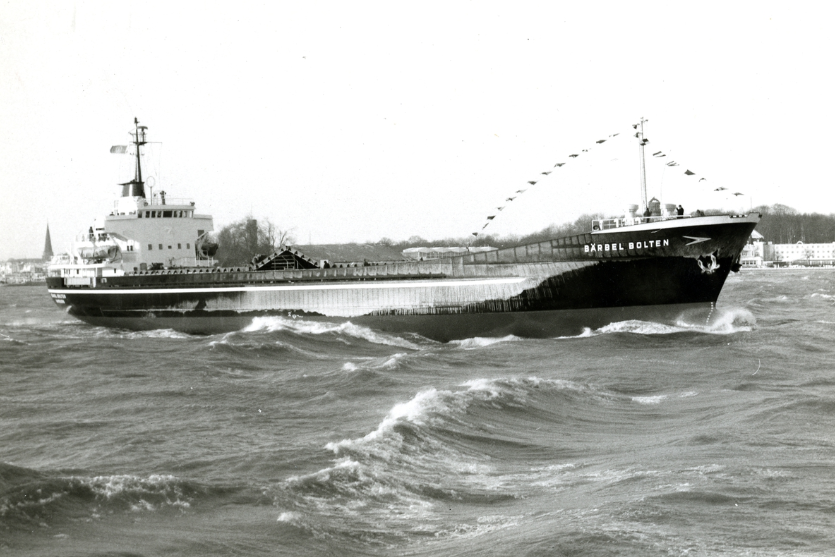
The MS Bärbel, before the horrifying incident
In his desperation, he tied heavy iron bardun tighteners to the legs of all five victims and threw their bodies overboard. He then meticulously cleaned the ship to remove any traces of the crime.
From August 15, when the murders occurred, until August 18, Lapin sailed aimlessly in the North Sea. To justify his presence in the life raft, he set the ship on fire. In his latest account, he confessed to two murders in self-defense. This version of events remained consistent and unchanged.
It is after this, as previously mentioned, on September 13, that Dutch fishermen recovered the body of Captain Heinrich Telkmann off the island of Texel. The body bore a severe brain lesion, likely from an axe blow, along with multiple stab wounds to the chest, corroborating Lapin’s account of the violent confrontation.
Andrej Lapin is Acquitted in the Barbel Murder Case
Early in the case, as mentioned before, the Ministry of Justice in Lower Saxony requested Andrej Lapin’s extradition for prosecution, given that both the ship and its captain were German. On December 13, Lapin was handed over to the German police at the border, allowing the judicial process to restart.
A video recording of the reconstruction on board the Bärbel in Esbjerg Harbor was shown during a German court hearing. Observers noted that Lapin seemed quite pleased with his appearance on the screen, attending court in a white, tight-fitting suit and matching shoes. His unnaturally composed demeanor, with hints of psychopathic traits, drew considerable attention both in Esbjerg and Germany.
A German professor of psychiatry analyzed Lapin and concluded that he was a very intelligent, ambitious, and determined individual, fully fit for punishment if it came to that. However, it did not. On February 3, 1995, the high court in Osnabrück acquitted Andrej Lapin.
“Despite all our efforts, we have not found the truth in this case. We could not refute Lapin’s claims. But there is no first or second-class acquittal. Acquittal only. And therefore, Andrej Lapin is now to be considered innocent,” said the presiding judge, Dr. Elmar Schuermann.

In this photo from the crime scene of the Bärbel, the ship that swallowed its crew
Only the arson charges were proven, resulting in a suspended sentence, allowing Andrej Lapin to walk free. Even the 60,000 DM, which he claimed was earned from selling Russian icons, remained in his possession, as no one could refute his claims.
In front of the spinning TV cameras, Lapin declared, “I feel sorry for the relatives of those killed. But I am innocent and acted out of necessity. And I would do it again.”
Despite his acquittal, it took nearly another year and a half before Lapin could finally breathe a sigh of relief, as the prosecution continued to pursue the case. By the end of summer 1996, Germany’s highest court, the Federal Court in Karlsruhe (Bundesgerichtshof), declined to take up the case. Three years after Lapin was first taken into custody in Esbjerg, he was definitively free.
After his acquittal, Lapin audaciously applied for a job on the Bärbel through Heinrich’s wife, who now owned the ship. Unsurprisingly, he did not get the job.
Why The Case of the Bärbel is Even More Unsettling?
However, even if we assume Lapin was lying about acting in self-defense, several unresolved issues cloud the case.
The ship’s intended journey time (Sunday morning to evening) and the fact that Heinrich did not answer Bärbel’s call on Monday suggest that whatever happened to the crew likely occurred on Sunday, August 15. Danish investigators believe the incident almost certainly took place within 48 hours of the ship departing London. Although it seems plausible that Lapin was responsible for the disappearances of Heinrich and the crew, as well as the attempted arson, the timing of his alleged plan raises questions.
Why would Lapin confront five other sailors and the captain shortly after leaving port, instead of waiting until the ship was closer to its destination? Given that Lapin was hired on August 9, why not rob the ship while it was docked in London between the 10th and 15th, and then escape with the cash? Lapin’s claim that he took the money to give to the families of the deceased is dubious, especially since he kept it, but that doesn’t necessarily mean he killed five men to obtain it.
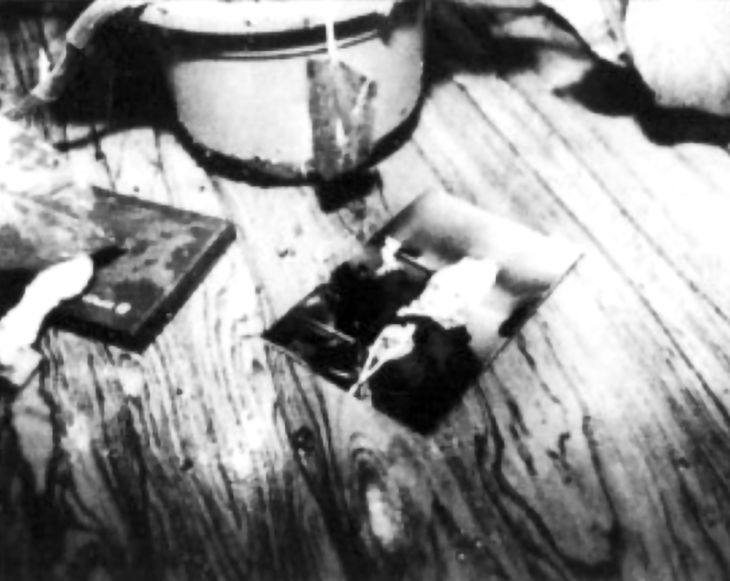
Traces of blood that were found on the ship
It should be noted that Lapin hailed from Kaliningrad, a small Russian exclave on the Baltic Sea bordered by Poland and Lithuania. It’s conceivable that he believed he could sail the ship through the North Sea and the Danish Straits, bringing it closer to home despite having no formal training. While he claimed in court that he attempted to navigate the ship, one would assume that learning to sail a vessel the size of the Bärbel would be essential before making such an attempt. Even if this was Lapin’s plan, it hinged on the improbable ability to kill five men without any of them fighting back enough to injure or kill him, thereby preventing his escape.
Regardless of what transpired that fateful August, the exact sequence of events and the motivations behind them remains a deep mystery to this day.
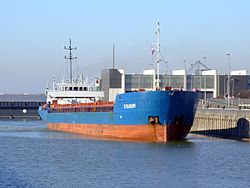
The MS Bärbel, the ship where the murders took place. Now it is sailing under the name of The Stadum
In 2009, reporters from Danish Radio tracked down Lapin in Russia. In a twist befitting a story rife with absurdities, he was found working as a middle manager at a sea rescue station.
The Bärbel itself continues to operate today under various names and owners since 1993. With Lapin the sole survivor, the ship remains the only other witness. Neither capable nor willing to reveal the truth, the events of that summer remain shrouded in mystery and are unlikely ever to make complete sense.
What do you think happened that weekend in the North Sea?
Next, read about John Favara, the man who accidentally killed John Gotti’s son, and paid the ultimate price. Then, about Horrifying Murder of Chandra Ann Levy.




































